Refine by Region
Refine by Art Form
Refine by School Level
A Space To Grow
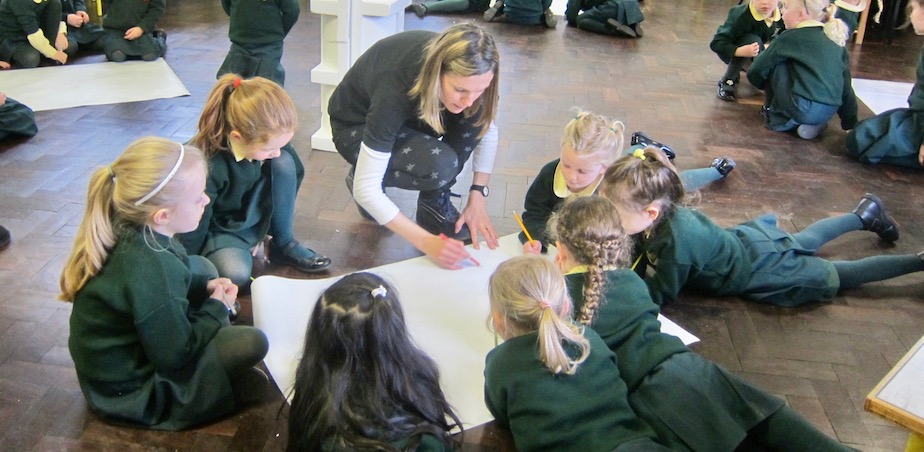
Designing the Rocket - Artist Helen Barry
Tell us the story of your project – What was the impetus? What was it about? Who was involved? How did you begin?
Helen Barry, Artist:
During my introductory meeting with the teacher Ms. Smyth, Sharon offered the brief “I would like the children to do something that they would normally never do in the classroom”. The children were in senior infants and aged between 5 and 6 years. The introductory session is extremely important in understanding the context of the school, the previous arts experience of the school and teacher and the schools based experience of the artist. I would like to highlight the word ‘Space’ as used in our title. We literally explored all possible definitions of the word and still continue to do so as we have a few sessions left. It was not an intentional theme but one that grew very organically from the moment I entered the classroom. The children’s classroom was the biggest space that I have ever worked in; it was Autumn and the children were exploring intergalactic space. My first actual workshop with the children focused on spatial awareness creating spaces using huge rolls of metallic foam and moving about in these temporary spaces. I had also brought with me a variety of materials to play with and included four pieces of white polystyrene that formed the main body of our rocket. We cannot give credit to any one being for this decision other than being a something that was on everyone’s mind in the classroom so it just all happened in a split second.
Through designing and building the rocket together the children began to understand structure and stability. With these new skills and a wide range of materials we further explored scale and constructions both inside and outside of the classroom. We built different spaces focusing on dome structures, a dominant shape that frequently appears throughout my work. As we constructed our structures we were met with many challenges. As we were ‘testing’ with materials and designs it was often the children who offered the solutions to building more stable pieces. Again I found that Sharon was really positive when met with these sort of challenges, when things collapsed she felt that this is where the children learnt more as it demanded more from them and often displayed a strong voice from children who often remained in the background. One of our domes has been given a permanent home in the school grounds. We have planted a willow dome that will grow with the children throughout their primary school journey with them. The children will tend to the willow dome in the coming years and I will maintain my relationship with Sharon, the children and the school.
Sharon Smyth, Teacher:
The offer of applying for the program was put forward by our school principal. Having read up on the initiative and what was involved I put my name forward to be considered. I felt that it was a great opportunity to offer my class something beyond that which my ability and confidence might allow if I were to tackle such a project on my own. During our initial meeting Helen spoke of construction, incorporating the classroom tables and chairs, rockets flying into space and using the top half of the room (from the ceiling down) to explore ‘Space’. I knew that a truly unique and exciting experience was possible for my girls, it just required a little leap of faith!
How were the ideas developed and how did the young people, artist and teacher work together?
Helen Barry Artist:
The immediacy of what we created in the first session provided the impetus for what developed over several months. Each idea rolled seamlessly into the next. We tested a number of ideas that came from discussions with the teacher and the children. Our rocket claimed centre stage as its design was carefully and enthusiastically managed by the children. The process demanded group work and teaming building. Often children as young as this can struggle with group decision-making. This group of senior infants rose to the challenge and seemed to grow in maturity and independence as the weeks progressed. Their teacher Sharon provided the space for the children and I to totally explore the ‘unknown’. Sharon has such a wonderful belief in each child’s abilities and is very open to discovering new ways of learning. She also proved that she was possibly more open than I was at times to leaving structure and routine aside and just going with the flow.
Sharon Smyth, Teacher:
Helen immediately looked to tie her work in with what the class were already learning about. This gained their attention and focus while at the same time taking their learning in a new and exciting direction. I watched (in awe) from week to week as my class became more efficient in teamwork, understanding of each other’s needs and willingness to take on the ideas of those around them (a very tricky task in the world of the ego centric 5/6year old!)
What was your personal experience of the project in terms of successes and challenges?
Helen Barry, Artist:
From the outset the scale of the materials we were working with demanded teamwork. Explaining to each team or group what they had to do I initially found challenging but as the work developed the children worked brilliantly in small teams, responding well to each other and supporting each other’s ideas and designs. So much so that when they were working on individual activities the children would automatically offer their assistance when they saw that someone needed it. The class size was large with 30 students. Initially the children seemed very young and the dynamic could heighten very easily but very quickly they became more capable and independent as the project developed.
Sharon Smyth, Teacher:
Initially I was a little at sea as to my role within the program/sessions. I wasn’t sure how much I was to observe or work hands-on with what the class were engaging with. As the weeks passed I felt that the more I tried the various activities, got involved and even on some occasions offered advice or help, the easier and more confident I became. While I hoped my own teaching would grow in this way through the program I am delighted that I would now have the confidence to try projects and lessons that are larger in scale and ‘space’ than I would ever have dared before.
What was significant for you about the project that is worth sharing?
Helen Barry, Artist:
The willow dome has provided a new material and timeframe for how I work. Planting willow cuttings has given root to another similar project. Since planting the willow dome with the children in St. Raphaela’s I have planted a second willow dome with children in St. John The Baptist P.S. in Belfast. This experience has demonstrated the openness of the primary school classroom. Sharon, along with so many teachers, has proven time and time again the willingness to engage with and support the arts and creativity in the classroom.
Sharon Smyth, Teacher:
I honestly don’t know where to begin in putting into words the value and worth of what my class has gained from their (and my) entire experience with Helen. Helen is not only an outstanding artist but she possesses an incredible understanding and appreciation of how her profession and skills can be brought to life within the classroom. While I have always loved to paint and ‘do art’ with classes I have taught I now realize that my vision and understanding of what ‘art’ teaching is has never truly reached its full potential. I sincerely believe that a product is not necessary at the end of a lesson but that the process is what is important but now I embrace this even more wholeheartedly.
Our space rocket, with its initial design, exploration of materials and slow but steady assembly took many weeks to complete before it managed to hang majestically (the word chosen by my class) from the middle of our ceiling. Alongside the many artistic lessons the girls engaged in, it was also a lesson in PATIENCE. I do not mean the patience required until it is your turn to stick or glue, cut or offer an idea. It was the patience of allowing the spaceship to build and come together over time. This required hours of collaboration, compromise and debate as week by week another element was added. Indeed at one point the wings of our spaceship were thought to be stained glass windows for Christmas by those passing by the room! To have rushed this project so as to have a ‘product’ by the end of two or three sessions would have meant missing out on a world of learning and discovery.
From our rocket we moved on quite seamlessly to building domes. Again we took this step by step exploring how best to support them – building foundations, securing poles side by side. It is how this was approached that I was enthralled by. One session saw the class link themselves together and learn how to form strong bonds between each loop. How much deeper is this learning than just ‘let’s build a dome’. What has come of this in the most organic way (planting our own dome) is absolutely fascinating. Over the coming years the dome will grow and develop alongside the girls. Helen has agreed to return to the school each year and work with the class in a number of sessions to shape and maintain the structures. The learning and integration that will occur across the curriculum as both the girls and structures progress will be a very special experience and we are very grateful to Helen for her commitment of time and expertise in the project.
Has anything changed in your work as a result of the project?
Helen Barry, Artist:
Experiment and exploring with new ideas and materials naturally results in some things that do not work. At times I find this quite unnerving if somewhat stressful feeling that I let the children down. Sharon is very skilled in demonstrating and supporting ‘mistakes’ that don’t always turn out to have been for the best. I hope to be able to use her perspective in how I deal with challenging situations in the future. Planting willow has been a new departure in using materials. The maintaining of the willow dome will enable or demand that I will be working on a project that will grow and change over many years.
Sharon Smyth, Teacher:
The biggest thing I feel that has changed in my work as a teacher is that I would now be happy to allow my art lessons carry for a number of weeks without feeling the pressure to ‘have something on the wall’ or ‘a picture to send home on a Friday’. So many of our lessons were tied into building our rocket and yet they splintered off more often than not into lessons of their own, producing space asteroids one week and pasta based constructions another. It has also reiterated for me how paramount it is to allow children engage in as many mediums for learning as possible. What best appeals to one child’s ability to learn will not appeal to another. On so many occasions I witnessed children who struggle in the day-to-day lessons of the classroom excel in the hands-on tasks put before them. Their confidence and self-belief literally grew in front of me as they mastered new skills and understanding
Spotlight
Artist(s):
This was my third Creative Practitioners Residence with a Junior/Senior Infants class that was supported by DLRCC. These three residences and some in-depth research has given me good understanding of the full curriculum for the lower end of the primary school. In these previous residences I have used some of the pedagogical methodologies and tools used in the classroom as key approaches to how and what we have explored and created in the classroom. Hence with the ‘brief’ offered I could see the fantastic potential for this collaboration. I also wanted to ensure that what we would created together would be relevant to the lives of the children, support the benefits of cross curriculum learning and sit comfortably within the perimeters of the curriculum. These three aims would support the continuity of my collaborative work within my practice.
The collaborative work with children is intrinsic to my practice. My focus is with early years and primary school children, creating work with them and sometimes for them. Through sculpture, installation, printmaking, movement, and sound we explore ideas of community, self and belief. Paramount to a successful collaboration is the relationship between me the artist and the primary caregiver of the child; the teacher, child care professional or the parent.
Teacher(s):
I have been teaching now for almost 15 years and I very much wanted to breathe some new life into my approach towards the artistic side of my classroom. I have a keen interest in the arts but would have a lot more experience within the areas of music and drama. Therefore, the opportunity to explore the ‘visual art’ element really appealed to me. I firmly believe that children will rise to any challenge you set for them. What they achieve within this challenge and their experience and depth of learning while doing so is, as an educator your No.1 priority and responsibility.
I love to try something new, no new learning is a waste and so the potential for expanding your own ability and experience as a teacher is endless.
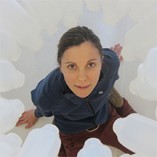
Artist(s)
Helen Barry

Teacher(s)
Sharon Smyth
Artforms
School Level
School/
Participant Group
St. Raphaela’s Primary School, Stillorgan, Co. Dublin
No. Participants
30
Region
Age/Class
Senior Infants 5-7 years
Dates
Dec 2016 - May 2017
Weblinks
Leading Agency
Dun Laoghaire Rathdown Arts Office
Key themes/ lines of enquiry
Spatial Awareness, Solution Focused, Design & Construction of Structures, Sculpture, Group Work, Communication, Growth.
The process supports the key aims and objectives of Aistear.
Curriculum Strands
S.E.S.E - Science & Geography
Music- Listening & Responding
English - Writing & Oral Language
Maths – Algebra
- Shape & Space
- Measures
While I hoped my own teaching would grow in this way through the program, I am delighted that I would now have the confidence to try projects and lessons that are larger in scale and ‘space’ than I would ever have dared before.
Sharon Smyth, Teacher
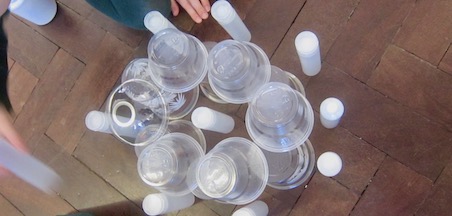
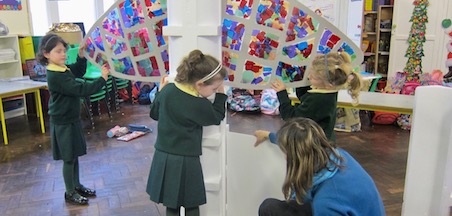
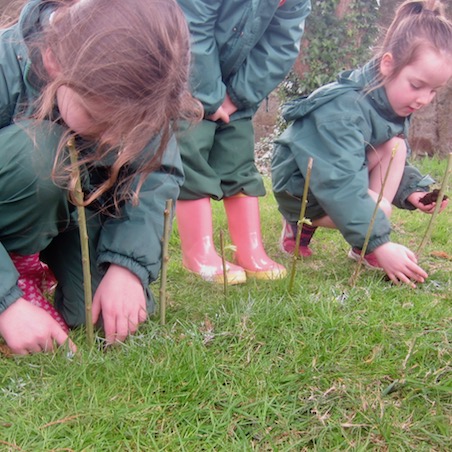
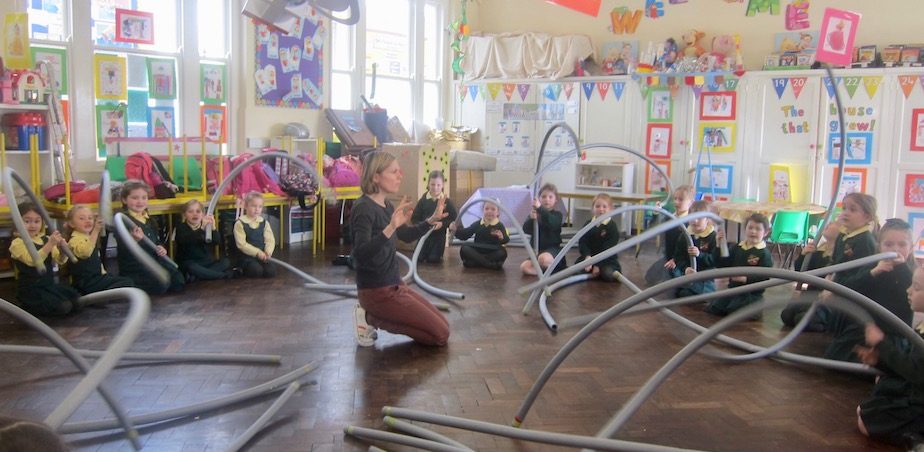

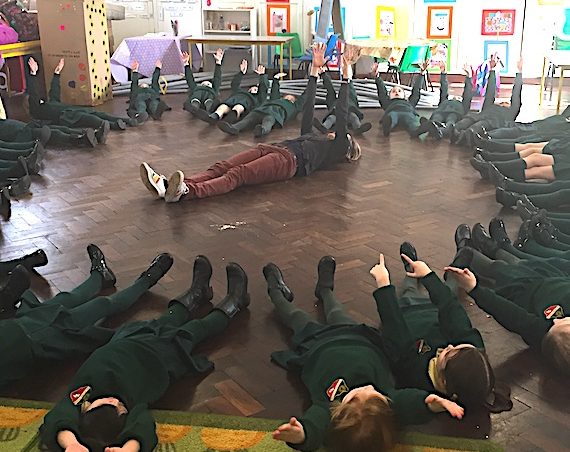
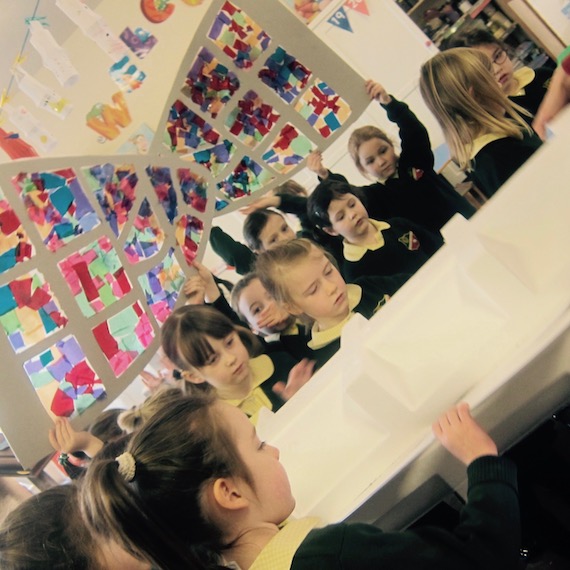
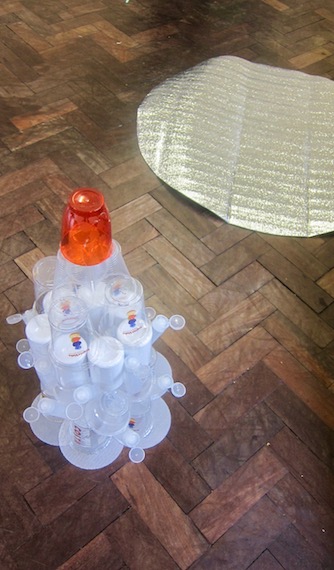
Similar Projects

Learning About Learning
Artist Helen Barry works with Teacher Joanna McCallig and Junior Infant children from Dominican National School, Dun Laoghaire.
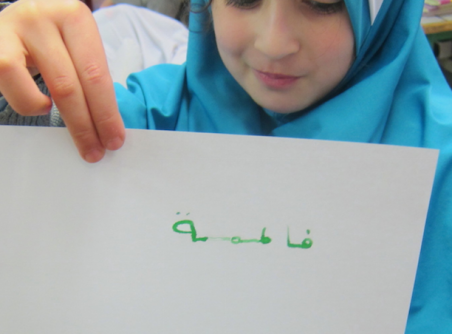
Cubes and Compromise
Visual artist Helen Barry engaged in a 12week collaborative residency with 1st class children in the Muslim National School, Clonskeagh. Together they explored components of Islamic art and design using a cross-curricular approach.